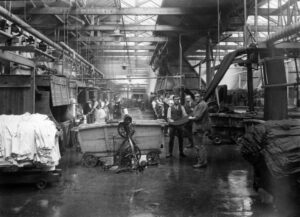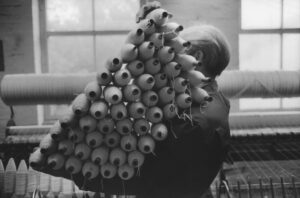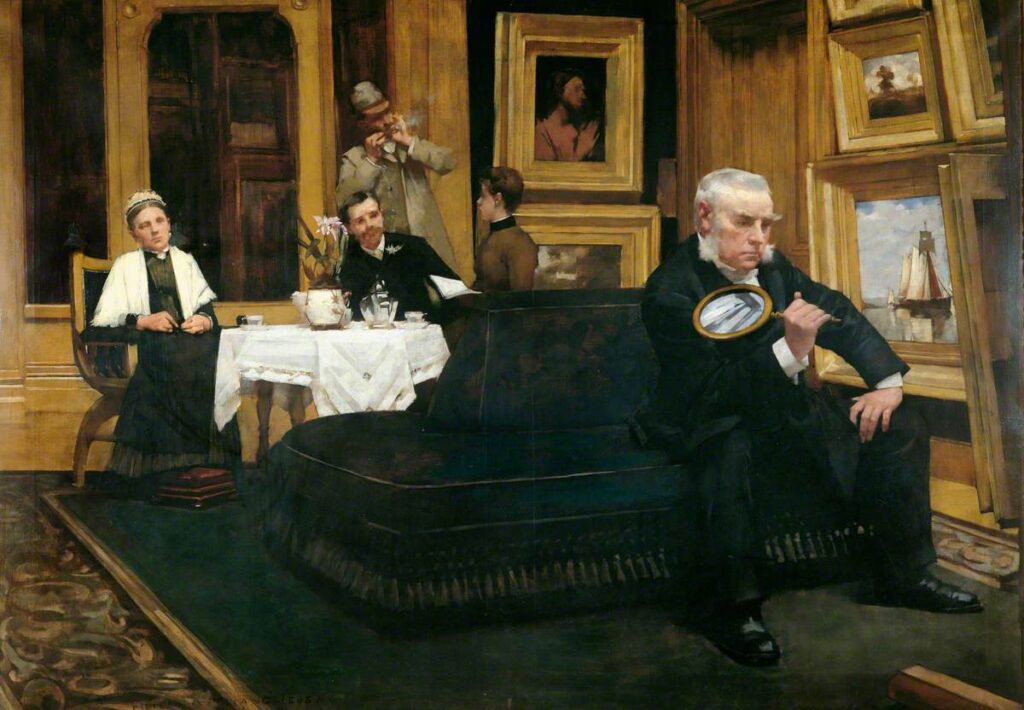This week’s blog post has been written by Liz McIvor, our Curator for Technology & Social History. She writes:
The temporary exhibition, Grafters (3rd December 2016- 5th November 2017) was developed in Partnership between the Bradford born Photographer Ian Beesley, and the People’s History Museum in Manchester, where it was shown in 2016.
It contains images from a number of northern museum collections, including Bradford’s, of people at work. They are mostly engaged in industrial or manual labour, some photographed posing, others without their knowledge, but the wide range of images (1870’s to the 1990’s) capture people’s lives as well as the world changing around them.
Those working in demolition, construction, manual labour; the hard and heavy work of mining, making things in factories, and being out in all weathers would be referred to as one homogenous group called the ‘working class’.
The Oxford English Dictionary defines ‘working class’ (noun) as a person who works in a manual or industrial job directly for wages. The adjective use is to describe things as being ‘working class’ such as having a ‘working class’ attitude, or a pub being a ‘working class’ boozer.
Of course, looking at class divisions in society today will make it obvious that there is no single identical experience in any community. A person may be brought up in poverty, but may be able to find a way to get themselves out of poverty as an adult, find well paid work, move to a popular residential area and bring up their family in luxury. Does this mean that the person’s class identity has changed? Has it affected the class identity of their children, or grandchildren?
Even in Victorian Britain, that most class conscious society, it wasn’t straightforward.

Someone who was considered ‘working class’ because they were a Weaver or a Foundry-man might not have considered themselves in the same class as a miner or a farm labourer.

As in wider society, there were lots of different levels which made up people’s notions of ‘class’. It often had very little to do with the amount of disposable income a person had, as the idea that class could be ‘inherited’ was a strong one. Many people believed that belonging to a certain class of society had something to do with a ‘natural order’ and breeding. Namely; that people in the upper levels of society were there because they were the product of the best breeding and had natural refinements which entitled them to their positions. For people who believed this, the idea of ‘mixing’ with people from other backgrounds, even if they were financially similar, was unacceptable.
Bradford Museums and Galleries Art collection includes a portrait by Henry Herbert La Thangue painted in 1887 called ‘The Conoisseur’. The Artist was best known for painting ‘realistic’ portraits, mostly of rural labourers cutting wheat, boat builders and the like. In this curious painting, a wealthy man sits separately from his wife and adult children with a magnifying glass in his hand. He is surrounded by expensively gilt framed works of art, a bookcase full of leather-bound classics, the picture of upper class comfort. There are almost too many paintings around him. He doesn’t seem at ease with the scene or his family. Why not? Is all this an effort to join a group he doesn’t really feel a part of?

We can usually follow the lives and backgrounds of the rich and their navigation of the class system fairly easily. An industrialist who makes a small business into a superpower, owning half the town in the 1790’s will have a very different experience to that of his sons, and grandsons, who may not even acknowledge where the money came from in the first place.
But what of the other end of the spectrum? It is much harder to find the people at the bottom of the pile. Even if they appear in records, they rarely leave much more of themselves behind to interpret their lives.
These were the people who made climbing the class ladder possible for so many different people in the 18th and 19th centuries. In northern cities, thousands were forced together to work and live in larger communities than had ever been the case, and although their personal circumstance and attitudes would differ, what brought them together was usually their experience of work.
‘Graft’ is an Anglo-Saxon expression meaning to dig a hole. A ‘Grafter’ became a catch all term for someone who labours, and the ‘grafters’ captured in this new urban landscape would have to find ways to establish new identities in an unfamiliar setting. Tribal groups began to appear based on the work a person did, or even who for. Old land – based loyalties were now the loyalties of working for a particular mill Master, for a quarry, a limeworks, or ironworks, being either a Lancashire and Yorkshire Railway man or a Midland Railway man.
Although, looking at the photographs may give the impression of a grim existence, struggling to eke out a living; gradual change was taking place in the working classes as well as those above whose expectations and behaviour had changed as a result of the urban society.
In a culture of improvement and innovation, where productivity was celebrated, people began to see that working conditions and aspirations would also have to change. Arthur Toynbee visited the Bradford Mechanics Institute in 1880 and said
“It is not merely a question of the distribution of wealth, it is a question of the right use of wealth. High wages are not an end in themselves. No one wants high wages in order that working men indulge in mere sensual gratification.
We want higher wages in order that an improved material condition, with less anxiety and less uncertainty as to the future, may enable the working man to enter into a purer and more worthy life.”
Toynbee and other campaigners were trying to raise standards of living and by doing so, raise standards of expectation. In their own words, they were trying to ‘free’ people, not from being working class, or from doing the necessary jobs which kept the country economically powerful, but from the hand to mouth existence which prevented most of them becoming educated or making the best possible use of their talent, thereby making Britain even greater.
Although it happened slowly, over just a few generations, political and social change ensured that hours were shorter, education became compulsory, and healthcare free. The Grafters would face fewer dangers at work and could join unions to protect them from unscrupulous employers. Paid holidays, public transport, libraries, council housing, parks, museums and charities all did their part to lessen the differences between people in the British class system.
But yet, the notion of class remains with us today. There may be far fewer miners or factory hands than there were 100 years ago, and although it cannot be denied that generally, standards of living have risen since then, class still has a great affect on our behaviour in society and the way we deal with other people. There is still an enormous gap between groups of people depending on the types of work they do, where and how they live. It is interesting to look closely at these evocative images and work out which are the modern equivalents in today’s society, and how (indeed IF) they will be documented for the generations to come.
